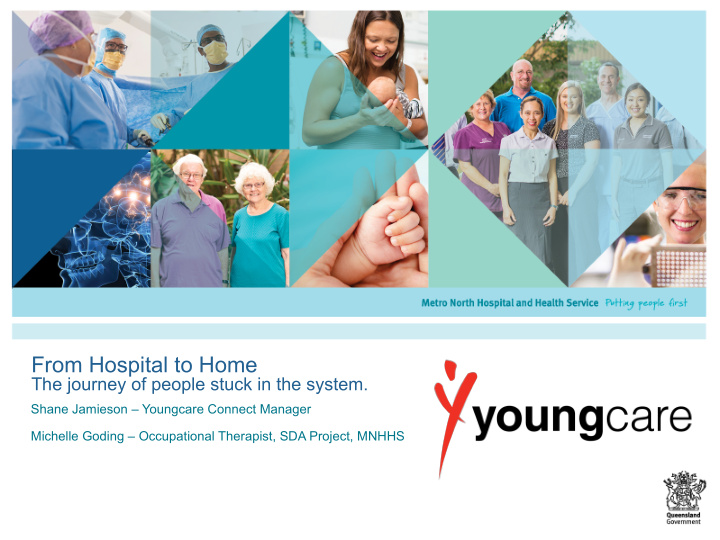



From Hospital to Home The journey of people stuck in the system. Shane Jamieson – Youngcare Connect Manager Michelle Goding – Occupational Therapist, SDA Project, MNHHS
Introduction Metro North Hospital and Health Service 2
Background – Metro North Hospital and Health Service (MNHHS) 3
Background – MNHHS – Fast Facts Metro North Hospital and Health Service, 2017–2018 Annual Report, www.metronorth.health.qld.gov.au Staff 15,781 (MOHRI FTE) Investment in care $2.758 billion Sites 5 hospitals with 2,286 available beds, 15 community service locations, 27 oral health facilities and 15 mental health facilities Hospital admissions 283,368 people admitted Ambulance arrivals 103,018 ambulance arrivals handled by our emergency departments Emergency 291,846 attendances Outpatient services 1,367,662 outpatient occasions of service Surgical operations 50,032 elective and emergency operations performed Children 23,324 children under age 18 were admitted to Metro North wards and units Births 8,243 babies born at our facilities Mental health 406,150 contacts Community health 147,163 hours of direct primary care X-ray and ultrasound 300,333 x-ray and ultrasound attendances Dental 770,332 weighted occasions of service Breastscreens 43,031 breastscreens performed https://www.parliament.qld.gov.au/documents/tableOffice/TabledPapers/2018/5618T1697.pdf 4
SDA Project Role Objective -To achieve best possible housing outcomes for MNHHS NDIS participants. MNHHS ACAT – U65 Referrals Received Assessments Completed 70 60 60 56 56 49 50 40 30 20 10 0 July to September 2018 October to December 2018 5
2017 MNHHS Census Long-Stay Younger People with Disability Facility Type Number of People Percentage % Comparison to 2016 Census data Acute 8 3 8 Extended Care Facility 78 31.5 88 Residential Aged Facility 22 9 19 Mental Health 49 20 39 Community Care Units – Mental 54 21.5 50 Health Extended Care Facility – Mental 38 15 9 Health TOTAL MNHHS 249 people 100% 213 people (17% increase) Within Metro North HHS, 249 people were identified in the 2017 census in the facilities list in Table 1 142 (57.26%) of records reported in the 2016 census were reported again in the 2017 census.
SDA Project Role • Linking with NDIA to establish a SDA process for eligibility report/ proforma submission and approval. • Completing SDA eligibility reports. • NDIS pre-planning support – identifying information to build the case for best possible plan e.g. OT home visit report to evidence need for complex home modifications in 1 st plan. • Linking with NDIS Planners to achieve optimal housing outcomes. • Service provider/ housing provider contact. • Advice/ support to clinicians for “long-stay” patients re: NDIS/ SDA. • Family support through NDIS/ SDA process. 7
Case Study - Melanie 8
Case Study – Melanie SDA project role: • support provided to hospital OT to gather the clinical records (evidence) required to complete the SDA report/ panel proforma; • draft report completed; • phone review of report completed with OT; • Melanie was supported by hospital OT to visit SDA – Improved Liveability – unit – single dwelling. • SDA report/ proforma submitted. Outcomes: • Identification of accommodation options – application submitted to SDA provider – offer to be made pending SDA approval outcome. • Fast-tracked process to prevent admission RACF. Improve patient flow through acute facility. • Client focused, goal directed approach. 9
Outcomes: SDA SUBMITTED VS. APPROVALS SDA ready for submission SDA reports submitted SDA approved 30 28 25 22 20 15 10 5 2 0 October 2018 to March 2019 10
MNHHS SDA PROJECT NDIS PARTICIPANT HOUSING OUTCOMES 44 6 2 1 9 Inpatient (Exploring Housing Options) Home/ Complex Home Mods RACF SDA SSA/ SIL 0 5 10 15 20 25 30 35 40 45 50 11
Outcomes: • Building connections with MNHHS clinicians for NDIS planning, including SDA. • Submitting SDA reports/ proformas for long stay patients across MNHHS. • Networking/ planning with clinicians to explore housing options and the SDA report/ proforma writing processes. • Established working contacts within NDIA re: SDA approvals/ processes. 12
Challenges/ Risks: • Process for SDA approval. • NDIS participants may accept SIL accommodation (not SDA approved). • NDIS Support Coordination process vs. MNHHS discharge process. 13
Conclusion - Where to next? • Continue to follow up SDA approvals for MNHHS participants. • Ongoing linking of participants to accommodation options best suited to their support needs. • Provide SDA and NDIS planning education and resources to MNHHS clinicians to improve quality of NDIS plan and SDA outcomes. • Develop a SDA pathway for MNHHS NDIS participants. • Explore opportunities/ benefits of partnership model across other hospital and health services within Australia. 14
Recommend
More recommend